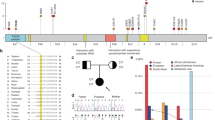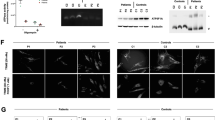Abstract
Patients with cutis laxa (CL) have wrinkled, sagging skin with decreased elasticity. Skin symptoms are associated with variable systemic involvement. The most common, genetically highly heterogeneous form of autosomal recessive CL, ARCL2, is frequently associated with variable metabolic and neurological symptoms. Progeroid symptoms, dysmorphic features, hypotonia and psychomotor retardation are highly overlapping in the early phase of these disorders. This makes the genetic diagnosis often challenging. In search for discriminatory symptoms, we prospectively evaluated clinical, neurologic, metabolic and genetic features in our patient cohort referred for suspected ARCL. From a cohort of 26 children, we confirmed mutations in genes associated with ARCL in 16 children (14 probands), including 12 novel mutations. Abnormal glycosylation and gyration abnormalities were mostly, but not always associated with ATP6V0A2 mutations. Epilepsy was most common in ATP6V0A2 defects. Corpus callosum dysgenesis was associated with PYCR1 and ALDH18A1 mutations. Dystonic posturing was discriminatory for PYCR1 and ALDH18A1 defects. Metabolic markers of mitochondrial dysfunction were found in one patient with PYCR1 mutations. So far unreported white matter abnormalities were found associated with GORAB and RIN2 mutations. We describe a large cohort of CL patients with neurologic involvement. Migration defects and corpus callosum hypoplasia were not always diagnostic for a specific genetic defect in CL. All patients with ATP6V0A2 defects had abnormal glycosylation. To conclude, central nervous system and metabolic abnormalities were discriminatory in this genetically heterogeneous group, although not always diagnostic for a certain genetic defect in CL.
Similar content being viewed by others
Log in or create a free account to read this content
Gain free access to this article, as well as selected content from this journal and more on nature.com
or
References
Van Maldergem L, Loeys B : FBLN5-related cutis laxa; in: Pagon RA, Bird TD, Dolan CR, Stephens K, Adam MP (eds): GeneReviews. Seattle, WA, USA: University of Washington, Seattle, 1993.
Morava E, Guillard M, Lefeber DJ, Wevers RA : Autosomal recessive cutis laxa syndrome revisited. Eur J Hum Genet 2009; 17: 1099–1110.
Kaler SG : ATP7A-related copper transport diseases-emerging concepts and future trends. Nat Rev Neurol 2011; 7: 15–29.
Kaler SG, Gallo LK, Proud VK et al: Occipital horn syndrome and a mild Menkes phenotype associated with splice site mutations at the MNK locus. Nat Genet 1994; 8: 195–202.
Zhang MC, He L, Giro M, Yong SL, Tiller GE, Davidson JM : Cutis laxa arising from frameshift mutations in exon 30 of the elastin gene (ELN). J Biol Chem 1999; 274: 981–986.
Markova D, Zou Y, Ringpfeil F et al: Genetic heterogeneity of cutis laxa: a heterozygous tandem duplication within the fibulin-5 (FBLN5) gene. Am J Hum Genet 2003; 72: 998–1004.
Loeys B, Van Maldergem L, Mortier G et al: Homozygosity for a missense mutation in fibulin-5 (FBLN5) results in a severe form of cutis laxa. Hum Mol Genet 2002; 11: 2113–2118.
Megarbane H, Florence J, Sass JO et al: An autosomal-recessive form of cutis laxa is due to homozygous elastin mutations, and the phenotype may be modified by a heterozygous fibulin 5 polymorphism. J Invest Dermatol 2009; 129: 1650–1655.
Renard M, Holm T, Veith R et al: Altered TGFbeta signaling and cardiovascular manifestations in patients with autosomal recessive cutis laxa type I caused by fibulin-4 deficiency. Eur J Hum Genet 2010; 18: 895–901.
Urban Z, Hucthagowder V, Schurmann N et al: Mutations in LTBP4 cause a syndrome of impaired pulmonary, gastrointestinal, genitourinary, musculoskeletal, and dermal development. Am J Hum Genet 2009; 85: 593–605.
Callewaert B, Su CT, Van Damme T et al: Comprehensive clinical and molecular analysis of 12 families with type 1 recessive cutis laxa. Hum Mutat 2013; 34: 111–121.
Hucthagowder V, Morava E, Kornak U et al: Loss-of-function mutations in ATP6V0A2 impair vesicular trafficking, tropoelastin secretion and cell survival. Hum Mol Genet 2009; 18: 2149–2165.
Kornak U, Reynders E, Dimopoulou A et al: Impaired glycosylation and cutis laxa caused by mutations in the vesicular H+-ATPase subunit ATP6V0A2. Nat Genet 2008; 40: 32–34.
Morava E, Lefeber DJ, Urban Z et al: Defining the phenotype in an autosomal recessive cutis laxa syndrome with a combined congenital defect of glycosylation. Eur J Hum Genet 2008; 16: 28–35.
Mohamed M, Kouwenberg D, Gardeitchik T, Kornak U, Wevers RA, Morava E : Metabolic cutis laxa syndromes. J Inherit Metab Dis 2011; 34: 907–916.
Van Maldergem L, Yuksel-Apak M, Kayserili H et al: Cobblestone-like brain dysgenesis and altered glycosylation in congenital cutis laxa, Debre type. Neurology 2008; 71: 1602–1608.
Guernsey DL, Jiang H, Evans SC et al: Mutation in pyrroline-5-carboxylate reductase 1 gene in families with cutis laxa type 2. Am J Hum Genet 2009; 85: 120–129.
Reversade B, Escande-Beillard N, Dimopoulou A et al: Mutations in PYCR1 cause cutis laxa with progeroid features. Nat Genet 2009; 41: 1016–1021.
Kretz R, Bozorgmehr B, Kariminejad MH et al: Defect in proline synthesis: pyrroline-5-carboxylate reductase 1 deficiency leads to a complex clinical phenotype with collagen and elastin abnormalities. J Inherit Metab Dis 2011; 34: 731–739.
Yildirim Y, Tolun A, Tuysuz B : The phenotype caused by PYCR1 mutations corresponds to geroderma osteodysplasticum rather than autosomal recessive cutis laxa type 2. Am J Med Genet Pt A 2011; 155A: 134–140.
Bicknell LS, Pitt J, Aftimos S, Ramadas R, Maw MA, Robertson SP : A missense mutation in ALDH18A1, encoding Delta1-pyrroline-5-carboxylate synthase (P5CS), causes an autosomal recessive neurocutaneous syndrome. Eur J Hum Genet 2008; 16: 1176–1186.
Baumgartner MR, Hu CA, Almashanu S et al: Hyperammonemia with reduced ornithine, citrulline, arginine and proline: a new inborn error caused by a mutation in the gene encoding delta(1)-pyrroline-5-carboxylate synthase. Hum Mol Genet 2000; 9: 2853–2858.
de Barsy AM, Moens E, Dierckx L : Dwarfism, oligophrenia and degeneration of the elastic tissue in skin and cornea. A new syndrome? Helvetica Paediatrica Acta 1968; 23: 305–313.
Kivuva EC, Parker MJ, Cohen MC, Wagner BE, Sobey G : De Barsy syndrome: a review of the phenotype. Clin Dysmorphol 2008; 17: 99–107.
Hennies HC, Kornak U, Zhang H et al: Gerodermia osteodysplastica is caused by mutations in SCYL1BP1, a Rab-6 interacting golgin. Nat Genet 2008; 40: 1410–1412.
Basel-Vanagaite L, Sarig O, Hershkovitz D et al: RIN2 deficiency results in macrocephaly, alopecia, cutis laxa, and scoliosis: MACS syndrome. Am J Hum Genet 2009; 85: 254–263.
Albrecht B, de Brouwer AP, Lefeber DJ et al: MACS syndrome: a combined collagen and elastin disorder due to abnormal Golgi trafficking. Am J Med Genet Pt A 2010; 152A: 2916–2918.
Syx D, Malfait F, Van Laer L et al: The RIN2 syndrome: a new autosomal recessive connective tissue disorder caused by deficiency of Ras and Rab interactor 2 (RIN2). Hum Genet 2010; 128: 79–88.
Kleefstra T, Wortmann SB, Rodenburg RJ et al: Mitochondrial dysfunction and organic aciduria in five patients carrying mutations in the Ras-MAPK pathway. Eur J Hum Genet 2011; 19: 138–144.
Berk DR, Bentley DD, Bayliss SJ, Lind A, Urban Z : Cutis laxa: a review. J Am Acad Dermatol 2012; 66: 842 e841–817.
Brunetti-Pierri N, Piccolo P, Morava E et al: Cutis laxa and fatal pulmonary hypertension: a newly recognized syndrome? Clin Dysmorphol 2011; 20: 77–81.
Gardeitchik T, de Leeuw N, Nijtmans L et al: Infant with MCA and severe cutis laxa due to a de novo duplication 11p of paternal origin. Am J Med Genet Pt A 2012; 158A: 469–472.
Cordeddu V, Di Schiavi E, Pennacchio LA et al: Mutation of SHOC2 promotes aberrant protein N-myristoylation and causes Noonan-like syndrome with loose anagen hair. Nat Genet 2009; 41: 1022–1026.
van Eijk HG, van Noort WL : The analysis of human serum transferrins with the PhastSystem: quantitation of microheterogeneity. Electrophoresis 1992; 13: 354–358.
Wopereis S, Grunewald S, Morava E et al: Apolipoprotein C-III isofocusing in the diagnosis of genetic defects in O-glycan biosynthesis. Clin Chem 2003; 49: 1839–1845.
Miller SA, Dykes DD, Polesky HF : A simple salting out procedure for extracting DNA from human nucleated cells. Nucleic Acids Res 1988; 16: 1215.
Hyvola N, Diao A, McKenzie E, Skippen A, Cockcroft S, Lowe M : Membrane targeting and activation of the Lowe syndrome protein OCRL1 by rab GTPases. EMBO J 2006; 25: 3750–3761.
Zampatti S, Castori M, Fischer B et al: De Barsy syndrome: a genetically heterogeneous autosomal recessive cutis laxa syndrome related to P5CS and PYCR1 dysfunction. Am J Med Genet Pt A 2012; 158A: 927–931.
Kouwenberg D, Gardeitchik T, Wevers RA, Häberle J, Morava E : Recognizable phenotype with common occurrence of microcephaly, psychomotor retardation, but no spontaneous bone fractures in autosomal recessive cutis laxa type IIB due to PYCR1 mutations. Am J Med Genet Pt A 2011; 155A: 2331–2332.
Lin DS, Chang JH, Liu HL et al: Compound heterozygous mutations in PYCR1 further expand the phenotypic spectrum of De Barsy syndrome. Am J Med Genet Pt A 2011; 155A: 3095–3099.
Lin DS, Chang JH, Liu HL et al: A novel mutation in PYCR1 causes an autosomal recessive cutislaxa with premature aging features in a family. Am J Med Genet Pt A 2011; 155A: 1285–1289.
Skidmore DL, Chitayat D, Morgan T et al: Further expansion of the phenotypic spectrum associated with mutations in ALDH18A1, encoding Δ1-pyrroline-5-carboxylate synthase (P5CS). Am J Med Genet Pt A 2011; 155A: 1848–1856.
Martinelli D et al: Understanding pyrroline-5-carboxylate synthetase deficiency: clinical, molecular, functional, and expression studies, structure-based analysis, and novel therapy with arginine. J Inherit Metabol Dis 2012; 35: 761–776.
Fischer B, Dimopoulou A, Egerer J et al: Further characterization of ATP6V0A2-related autosomal recessive cutis laxa. Hum Genet 2012; 131: 1761–1773.
Acknowledgements
We are thankful for the technical support of Rolf Pfund and Karin Huyben. The study was supported by the Institute of Genetic and Metabolic Disease.
Author information
Authors and Affiliations
Corresponding author
Ethics declarations
Competing interests
The authors declare no conflict of interest.
Additional information
Supplementary Information accompanies this paper on European Journal of Human Genetics website
Rights and permissions
About this article
Cite this article
Gardeitchik, T., Mohamed, M., Fischer, B. et al. Clinical and biochemical features guiding the diagnostics in neurometabolic cutis laxa. Eur J Hum Genet 22, 888–895 (2014). https://doi.org/10.1038/ejhg.2013.154
Received:
Revised:
Accepted:
Published:
Issue date:
DOI: https://doi.org/10.1038/ejhg.2013.154
Keywords
This article is cited by
-
Autosomal recessive cutis laxa type 1C with a homozygous LTBP4 splicing variant: a case report and update of literature
Molecular Biology Reports (2022)
-
New insight into clinical heterogeneity and inheritance diversity of FBLN5-related cutis laxa
Orphanet Journal of Rare Diseases (2021)
-
Homozygous deletion of MYADML2 in cranial asymmetry, reduced bone maturation, multiple dislocations, lumbar lordosis, and prominent clavicles
Journal of Human Genetics (2021)
-
GORAB scaffolds COPI at the trans-Golgi for efficient enzyme recycling and correct protein glycosylation
Nature Communications (2019)
-
Expanding the phenotype of metabolic cutis laxa with an additional disorder of N-linked protein glycosylation
European Journal of Human Genetics (2018)



